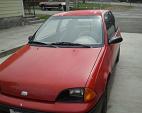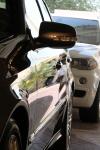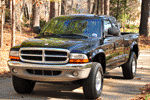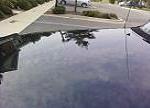 Dislikes: 0
-
Super Member

Re: 1957 Chevrolet Belair Extreme Makeover - Flex 3401 & Wolfgang Smackdown!
Could'a sworn I made a comment!
Looks awesome Mike, despite the solvent popping!
Those pads sure look my pads working on my boy's pickup with SS paint and dark blue!
Awesome car and great connection to an upholstery shop to boot!
My dad's an electrician and trades work all the time, smart. He got a nice 22' sled boat at a reduced price and custom work for fishing in exchange for wiring up their shops.
Aaron's the name!
Live long and prosper Leonard Nimoy 
-
Junior Member

Re: 1957 Chevrolet Belair Extreme Makeover - Flex 3401 & Wolfgang Smackdown!
-
Re: 1957 Chevrolet Belair Extreme Makeover - Flex 3401 & Wolfgang Smackdown!
 Originally Posted by Bunky

Mike, you said that one could use a larger work area with the flex (something larger than 2x2). What would you say is the optimum size?
Good question, just to clarify for everyone reading this, I never specifically said you could work a section larger than 2x2, here's a quote from what I wrote,
 Originally Posted by Mike.Phillips@Autogeek

Because of it's power you can tackle a larger section than you would normally tackle when using a PC style DA Polisher but don't go crazy and try to tackle areas like half a hood at one time as it's too hard to focus on UMR if your section are too big.
Try to never buff a section wider than the with of your shoulders and usually a little smaller.
(UMR = Uniform Material Removal for a Uniform Appearance)
So normally, with a PC style polisher, you need to work small sections at a time when you're remove below surface defects like swirls and scratches and that all comes back to the fact that these types of tools have clutches which makes them safe, (the thing many people new to machine cleaning and polishing love), but also makes the cleaning step, (that means defect removal step), take longer because they are not as powerful as a direct drive tool.
That said, usually for myself, and others might tackle larger areas, I try to keep my work area for a PC style polisher around 16" to 20" squarish or so, in fact in this recent thread here's what I wrote,
Tips and Techniques for using the PC 7424XP Dual Action Polisher to remove Below Surface Defects
 Originally Posted by Mike.Phillips@Autogeek
Work small sections at a time
Dual action polishers that use a clutch, like this PC 7424XP are popular because they're safe. The reason they’re safe is because if you push down too hard on the head of the polisher the clutch will engage and the buffing pad will stop rotating. This will prevent you from burning through the paint and/or instilling swirls into the paint. Compared to a direct drive tool like a Rotary Buffer, this tool is dramatically safer in its manner of operation.
For this same reason that people love this style of polisher, (It’s safe and easy to use), you'll find out right away that it also limits you to only working small sections at a time in order to remove enough paint to level out the surface and remove the defects. In most cases you're only going to tackle a section about 16" to 18" inches square or so; usually a 2' section is too large and a 1' foot section is too small, so you'll want to find a balance between working too small an area and working too large of an area at one time.
Since you can only work small sections at a time, this means you’ll need to break each panel up into small sections kind of like Checkerboard or Patchwork Quilt.
That is you’ll take each panel of the car, (a panel would be a door or fender or the hood), and in your mind’s eye slice it up into dedicated sections approximately 16" to 18” squarish or so. Because not all panels are perfect squares you’ll need to let the panel be your guide and break-up each panel into these smaller sections no matter what the shape may be. What’s important is to only work a small section at a time while using overlapping passes to work your product.

The average size hood will be broken up into either 4 sections for a small hood, (Mini Cooper), or 6 sections, (Honda Pilot), or 9 sections, (Ford F150).
This isn't a hard and fast rule as softer or more workable a paint means you can tackle a larger section at a time and conversely, with harder paints, or less workable paints you'll want to shrink the size of your work area down.
The idea being to match the size of the section you're working to the workability of the paint, which you should discover when you do your Test Spot, which is addressed in this article. Experience helps a lot with judging work size area but the only way to get experience is to put some hours behind the polisher on multiple cars.
But to your question about how large an area a person can work using a Flex 3401?
There is no pat answer because all paints are different in their hardness and softness and depth of defects. For years I've been teaching people to do a Test Spot somewhere on a car if they've never worked on the paint before and try to get a feel for how easy or difficult the defects are coming out with your choice of products, pads, tools and skill level. Thus there is not blanket or absolute answer as to how large an area you can work with the Flex 3401 or any tool.
Usually sticking with an area that's no wider, and thus squared up with the width of your shoulders is good common sense advice. I just had Yancy measure the width of my shoulders and I'm at approximately 20" wide which is 4" short of 2 feet.
The Flex 3401 does have more power than any of the PC style polishers I've used and it is a direct drive tool, so there's no clutch to slow down the pad rotation if you apply more pressure to the head of the unit and for this reason you can carve out or tackle a larger section than you would on the same paint system if you were working with a PC style polisher.
So larger than 16 to 20" inches but somewhere around 24" inches squarish or so.
With a rotary of a Flex 3401 it's not that they don't have enough power to tackle larger sections, it's just that for most people it's harder to concentrate and properly work large areas when removing defects, (which means removing paint), and do a great job. For example on the hood of the 57 Chevy in this article; I could easily with my arm's reach run the polisher back and forth from the front of the hood to the rear lip of the hood and from the center of the hood line back to the seam along the fender where I would be standing. I could do this easily. The machine has enough power. For me personally, I think I would struggle with concentrating doing a great job of removing just enough paint to remove the defects because that's such a large section to tackle at once. Thus the, work a section no wider than your shoulder's advice for any power tool.
What are you working on?
Whatever it is, maybe do some testing to see where your comfort level is with the size of area you feel capable of tacking at one time with good control over the defect removal step. If I remember correctly you and I are about the same size in shoulder width so do some testing and let us know if what I've written above is accurate or if you think most people can tackle larger sections with the Flex or if they should stick with smaller sections when removing swirls and scratches.
Of course, just like a PC style tool, when applying a finishing wax or paint sealant, section size isn't as crucial because at this point in the process all you're trying to do is spread out the product, not remove defects, so you can easily tackle larger sections.

-
Super Member

Re: 1957 Chevrolet Belair Extreme Makeover - Flex 3401 & Wolfgang Smackdown!
Thanks Mike. I have usually used something slightly larger than a 16x16 area (gaged using a 16x16 microfiber towel) with my UDM. I will look at maybe using a 16x24 towel (or 20 x 20 square) as a base area with the flex. I tend to mark the areas with painters tape as I work.
-
Re: 1957 Chevrolet Belair Extreme Makeover - Flex 3401 & Wolfgang Smackdown!
 Originally Posted by Bunky

Thanks Mike. I have usually used something slightly larger than a 16x16 area (gaged using a 16x16 microfiber towel) with my UDM.
That's a good general way to carve out a section to work. The majority of all microfibers are 16" square and thats too small for most correction work unless the paint is really hard or the defects are really deep, thus the reason I couch my words when I write, work and area 16" to 18" squarish or even larger, just not too large.
 Originally Posted by Bunky

I will look at maybe using a 16x24 towel (or 20 x 20 square) as a base area with the flex. I tend to mark the areas with painters tape as I work.
When I taught the classes at Meguiar's in Irvine I would use the Supreme Shine in the garage as a visual indicator to show people how large an area to work with a G110 which is like a Porter Cable DA Polisher.
The Supreme Shine is 16" by 24" and I would take this microfiber and lay it out flat and then say,
If you're test spot shows that the defects are coming out pretty easily, then you can work an area about this size. If your test spot shows the defects are coming out slowly, then fold this towel in half and work a section about this size.
The microfiber folded in half of course being 16" by 12" which is close enough to 16" by 16" that most people get the idea which is don't try to work too large of an area at one time.
With the Flex, because it has plenty of power, (motor torque), and it's direct drive, (pad won't stop rotating under pressure), you can easily tackle a section 16" by 24", or 20" by 20", etc.
A lot of times the only panels that have such huge section to work on 'modern' cars are the hoods and doors, so when it comes to mapping out a section to work in your mind's eye as you remove the swirls out of whatever it is a person is working on, I coined a phrase borrowing from our friend Yoda of Star Wars that goes like this,
"Let the panel be your guide"
Thus if the panel is long and narrow you must adjust the size you tackle by taking into consideration the size and shape of the panel.
This is why doing a test spot on any car that you're unfamiliar with the paint is so important and you need to find out what it's going to take to reach your goal. If that's remove 99% of all the swirls and scratches or just the shallow swirls and scratches, your test spot should help you into dial in your process and this would include how large an area to work at one time.

-
Junior Member

Re: 1957 Chevrolet Belair Extreme Makeover - Flex 3401 & Wolfgang Smackdown!
Thanks Mike,
Your work is truly inspiring to professionals and weekend warriors alike. Did you video the entire project or just the ones in the thread?
Later,
Lee
P.S. It seems you have traded wild fires for afternoon thunderstorms and high humidity! BTW, did the humidity affect your product application/removal?
-
Newbie Member

Re: 1957 Chevrolet Belair Extreme Makeover - Flex 3401 & Wolfgang Smackdown!
Mike, as a newbie, and first time poster, I've lurked recently and really enjoyed this write up. Excellent, and informative work!
I've got a curious noob question though. After attending a recent local car show, I've had the opportunity to grab a couple jobs on some classics. Both have single stage work, which honestly, in the past had me concerned to the point of turning them down.
I'm ready to tackle them with some newfound knowledge, but there's one lingering question I have. And forgive me if I overlooked the answer in your report, but after your polishing work, are the pads you used salvageable, or do they need to be tossed? I'm just wondering if this needs to be figured into the cost of the detail.
In fact, if anyone who has experience with single stage work could help, I'd certainly appreciate it as well.
Thanks so much for your hard work, and desire to share it.
-Scott
-
Re: 1957 Chevrolet Belair Extreme Makeover - Flex 3401 & Wolfgang Smackdown!
 Originally Posted by 305Cane

Mike, as a newbie, and first time poster, I've lurked recently and really enjoyed this write up. Excellent, and informative work!
Hi Scott,
Thank you for the kind words and since this is your first post,
Welcome to Autogeek Online!

 Originally Posted by 305Cane

after your polishing work, are the pads you used salvageable, or do they need to be tossed?
Completely salvageable. Don't worry one little bit about the pigmented paint that transfers to the pad.
Remember, when you work on a clear coated car you have clear paint residue building up on the face of your pads also and in both cases you simply clean your pads and save them for the next job.
At yesterday's Advanced Class, everyone that used the Pad Washer was impressed with how well it cleaned the pads. Besides removing the product and paint build-up off the pads it makes the buffing process so much easier with better results.
I have some pictures of students using the pad washer at the class and the results and will try to post them tonight.
Pictures & Comments from October 4th, 2009 Sunday Detailing 102 - Advanced Class
If you're going to be buffing out cars regularly, then besides a quality polisher the next best investment you can make is a pad washer.
It enables you to get more use out of your pads and it enables you to work better, faster and cleaner.

-
Junior Member

Re: 1957 Chevrolet Belair Extreme Makeover - Flex 3401 & Wolfgang Smackdown!
Wow, what an awesome job Mike!
Have you tried the 7"Kompressor pads yet? I really love them and I was wondering how they would stand next to the Hydro pads.
-
Super Member

Re: 1957 Chevrolet Belair Extreme Makeover - Flex 3401 & Wolfgang Smackdown!
Mike,
Watching you use the flex 3401 I noticed a HUGE mistake I have probably been making with my PC... You move ALOT faster then I do and I have been wondering how people made 4 - 6 passes without product drying up i was gettign 2 -3 maybe 4 if I was lucky. I had read somewhere 1 inch/sec and i think I went over board. Is that the same speed you make passes with a PC just doing a smaller section?
I was moving less then 1/2 your speed, maybe 1/4 ur speed at times.
Thanks in advance
Chris
Similar Threads
-
By Mike Phillips in forum Product Reviews by Mike Phillips
Replies: 49
Last Post: 10-06-2018, 08:58 AM
-
By Mike Phillips in forum PICTURES: 3-Day CAR Detailing Bootcamp Classes
Replies: 6
Last Post: 08-13-2015, 01:08 PM
-
By Mike Phillips in forum PICTURES: Wednesday Night Detailing Classes
Replies: 10
Last Post: 06-26-2014, 07:02 AM
-
By Mike Phillips in forum Wednesday Night Detailing Classes - Info & Dates
Replies: 12
Last Post: 11-12-2012, 09:49 AM
-
By Mike Phillips in forum Off-Topic
Replies: 31
Last Post: 09-22-2009, 09:22 AM
 Members who have read this thread: 0
Members who have read this thread: 0
There are no members to list at the moment.
 Posting Permissions
Posting Permissions
- You may not post new threads
- You may not post replies
- You may not post attachments
- You may not edit your posts
-
Forum Rules
|
| S |
M |
T |
W |
T |
F |
S |
| 28 | 29 | 30 |
1
|
2
|
3
|
4
|
|
5
|
6
|
7
|
8
|
9
|
10
|
11
|
|
12
|
13
|
14
|
15
|
16
|
17
|
18
|
|
19
|
20
|
21
|
22
|
23
|
24
|
25
|
|
26
|
27
|
28
|
29
|
30
|
31
| 1 |
|












 Thanks:
Thanks:  Likes:
Likes:  Dislikes:
Dislikes: 


 Reply With Quote
Reply With Quote




Bookmarks